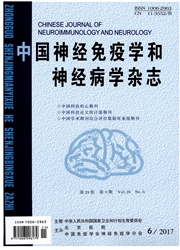

 中文摘要:
中文摘要:
目的总结行胸腺切除术的重症肌无力(MG)患者的疗效,并探讨影响近远期疗效的相关因素。方法回顾性分析作者医院收治的103例行胸腺切除术的MG患者的临床资料,采用卡方检验及Logistic回归分析可能影响疗效的因素。MG患者的近期及远期疗效分别用Monden、美国重症肌无力联盟(MGFA)分型进行评估。结果 103例患者中完成随访94例(91.26%),随访时间3个月~8年。近期疗效总有效率为60.2%,远期疗效总有效率为73.4%。发病年龄、性别、Osserman分型与术后近远期疗效均无相关(P〉0.05);病程(OR=0.240、95%CI:0.081~0.712,P〈0.05)、手术方式(OR=0.289、95%CI:0.110~0.757,P〈0.05)与近期疗效密切相关,是否合并胸腺瘤与远期疗效密切相关(OR=0.073、95%CI:0.009~0.575,P〈0.05)。结论病程越短,手术近期疗效越好;行胸腔镜手术较开胸手术能明显提高患者近期预后;MG不合并胸腺瘤者行胸腺切除术较合并胸腺瘤的患者更能从手术中获益。
 英文摘要:
英文摘要:
Objective To summarize the effect of thymectomy in patients with myasthenia gravis (MG), and to evaluate the factors influencing the short- and long-term outcome. Methods Clinical data of 103 MG patients underwent thymectomy in authors' hospital was retrospectively analyzed, and chi-squared test and logistic regression model were performed to analyze the related prognostic factors. The short- and the long-term effect were determined based on Monden and MGFA classification respectively. Results Among the 103 cases, 94 (91. 26%) were followed up and the follow-up time was between three months and eight years. The total effective rates of short-and the long-term effect were 60.2% and 73.4%, respectively. The onset age, gender and the Osserman type had no correlation with short- and long-term outcomes (P〉0.05). Duration of symptoms (OR=0.240, 95%CI: 0.081-0.712, P〈0.05) and surgical procedures (OR=0.289, 95%CI: 0.110-0.757, P%0.05) had significant correlations with short-term effect. Combined with thymoma or not had significant correlations with long-term effect (OR=0. 073, 95% CI: 0. 009-0. 575, P〈0.05). Conclusions Thymectomy can lead to better prognosis in shorter disease duration. The efficacy in patients who undergo thoracoscopic surgery is better than that in ones who undergo thoracic surgeryoperation. MG patients without thymoma benefit more from operation than the ones who have thymoma.
 同期刊论文项目
同期刊论文项目
 同项目期刊论文
同项目期刊论文
 期刊信息
期刊信息
